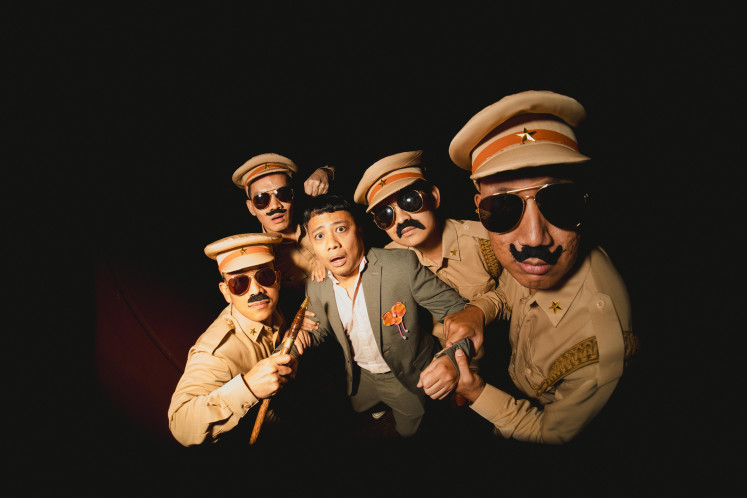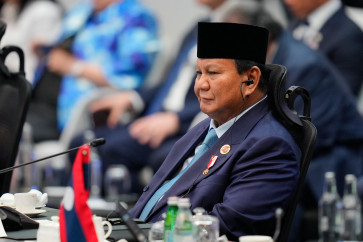Popular Reads
Top Results
Can't find what you're looking for?
View all search resultsPopular Reads
Top Results
Can't find what you're looking for?
View all search resultsSeeking purity, reviving a tradition at Kidal Temple
Sacred: A man tends to incense lit as part of the Ruwatan Sengkala Bur-Manuk at Kidal Temple
Change text size
Gift Premium Articles
to Anyone
Sacred: A man tends to incense lit as part of the Ruwatan Sengkala Bur-Manuk at Kidal Temple. The ruwatan, or the rite of purification, continues to be practiced by Javanese people in Central and East Java. It is believed to liberate humans from sins and blunders that have hindered them or that may yet affect their lives.
The rite has been performed since the era of the Singosari kingdom in the 13th century, when King Anusapati was said to have held a ruwatan at Kidal Temple in Malang to free his people and his mother, Ken Dedes, from restricting forces.
The tradition has been carried on up to the present, as shown by the ceremony that was recently held at Kidal Temple in Rejo Kidal village, around 20 kilometers east of Malang. The ritual, themed 'sengkala nagari bur-manuk' or ridding our lives of predicaments, was attended by 35 families.
Program organizer Kanjeng Raden Tumenggung Sutrimo Rekso Budoyo, the general chairman of the Institute for the Study, Preservation and Development of Javanese Culture (LP3BJ), said that holding the purification rite had been prompted by the local community's concern over the nation's worsening condition, with widespread hunger and misery among ordinary people.
'The ruwatan ceremony is expected to become an alternative means of getting free from and overcoming the bonds of our current quandaries, which in Javanese terminology are known as kala bendhu kebag pageblug,' Sutrimo said.
Hopeful: People wait for sumber songo holy water taken from nine springs in Central and East Java. Some attend the ruwatan purification ritual each year to seek blessings for their private and personal endeavors.
The ritual began with a dance drama telling a heroic tale depicted on the reliefs of Kidal Temple. Garudea, the main character in bird form, liberates his mother, Dewi Winata, from bondage imposed by his aunt Dewi Kadru. Garudea seeks the help of Vishnu to obtain tirta anumerta, or holy water.
With the power of the tirta anumerta, Garudea wins a fight against the guards confining Dewi Winata - three taksaka, or large snakes, who are actually her cousins.
The nation's founding president, Sukarno, is said to have traced the history of the Garudea, or eagle, to the reliefs of Kidal Temple. The bird was later adopted as part of the coat of arms of Indonesia after independence was declared.
Following the dance, prayers were performed under the direction of Sutrimo, who spoke in javanese, begging God to absolve the Indonesian people of their sins and ensure the smooth resolution of their problems. Meanwhile, others readied for the release the birds, or bur-manuk.
At least a thousand birds were released to symbolize the removal of predicaments in human life. 'The number set free are according to the participants' ages. The birds are mostly inexpensive and easily obtainable,' Sutrimo said.
Huge tumpeng rice cones were then served, along with a host of side dishes. There were three types of tumpeng, representing self-control, abundance and God's fulfillment of human pleas. After a prayer was offered, the food was savored by the ritual participants and visitors crowding the temple. Also served was sumber songo water, derived from nine water springs in East Java.
Representatives from the Surakarta palace were also on hand for the ritual, contributing 10 liters of sacred water from a spring near the palace. The ruwatan was observed on Kamis Pahing between the months of Sitra and Manggakala, according to the Javanese calendar.
Feast: Part of the ritual includes the presentation of three tumpeng rice cones, each with a different symbolic meaning.
While ruwatan were previously held on the birthday of the Singosari king, the ritual is currently observed on the birthday of Malang Regent Rendra Kresna.
Sutrimo said that there were several types of ruwatan, such as a sukerta for an only child, a kedhana-kedhini for a son and daughter, an uger-uger lawang for two sons, and a pendowo limo for five sons, which are usually accompanied by dusk-to-dawn shadow puppet performances.
There is also a ruwatan sasana, held for certain buildings or areas in villages. 'They are basically meant as a plea for mercy from God and for purification,' added Sutrimo.
One participant, Hari Sutrisno, 55, from Tumpang district, said he came to the ruwatan to enjoy the tumpeng and some holy water. 'I come to this ceremony every year so that my farming business will run smoothly,' Sutrisno, who was accompanied by his wife and two children, said.
In spite of heavy rain that began just as the birds were to be released, hundreds remained to follow the ritual from start to finish.
Sutrimo said that he hoped that the bur-manuk ruwatan would be a permanent addition to the calendar of Malang regency and magnet for tourists to visit Kidal Temple. 'This zone has apparently overlooked by tourists due to the hectic socio-cultural life in Malang.'
The road to Kidal Temple is now in fairly good condition. Although less popular than Singosari Temple and Jago Temple in Tumpang district, Kidal Temple has its own appeal.
Large and shady trees stand adjacent to the temple. The park around the structure is also neatly arranged, amid a rural environment that enhances the harmony of the entire zone. The only drawback that may disturb tourists visiting the Hindu temple is the less-than-pleasant odor coming from a poultry breeding area around the monument.
Sutrimo, however, has faith in the system that the temple will prevail. 'Based on the Cultural Heritage Law, the areas within a radius of 500 square meters of a heritage site must be free from settlements and businesses that might disturb its preservation. The regional government is expected to solve this problem in order to prevent social unrest.'
Storytelling: The ruwatan includes a dance that tells the story of Garudea as he attempts to liberate his mother Dewi Winata from bondage. The story of Garudea is inscribed on the walls of the temple.
Onlookers: Children watch a dancer perform the Sendra dance as part of the ruwatan.
' Photos by Nedi Putra AW















